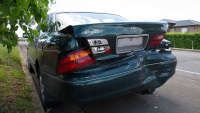However, the popular "softroaders" don't have low range. In which case, simply choose a lower gear. If your vehicle is automatic and has sports mode, then use that.
Keep the engine revving so it has power for when you hit soft sand. Be aware that an automatic gearbox can heat up in these conditions, so it's a good idea to rest the vehicle periodically.
The smoother you drive, the better. Don't make sharp turns because the vehicle won't respond. Instead, you will plough straight ahead, like understeering on a wet road. If this happens, unwind the steering and wind it on again. You may have to repeat this manoeuvre several times and slow down a little.
Turn in long, slow arcs a good distance before you need to avoid an obstacle. Place your hands gently at three and nine o'clock on the wheel and keep your thumbs pointing out. The steering wheel can get flicked around by ruts and can dislocate your thumb.
Don't fight the steering. Let it go where it wants. In deep, hard ruts you may need to "row" the steering wheel to gain traction on the sides of the ruts. Also, be smooth on the brakes. Sudden braking will lead to slides and can bog your vehicle.
If there are dunes on the beach, drive up swiftly but pause at the top in case traffic is coming the other way. Fit a tall flag on the front of your car so people can see you approaching from the other side of the dune.
Never turn on a dune. You can easily get bogged or roll. Don't follow too closely. If the vehicle in front becomes bogged, then you won't have time to steer around them or brake safely. If you follow a slow-moving vehicle too closely you also run the risk of losing momentum and getting bogged.
When you stop on the beach, park on hard sand. When taking off again, move slowly to avoid wheel spin then pick up speed as quickly and smoothly as possible. On beach tracks always give way to vehicles travelling uphill as they need to keep up momentum.
TOP 10 SAND DRIVING TIPS
1. Check tide times and drive at low tide.
2. Momentum is your friend, so keep revs high.
3. Deflate the tyres to about 18-20psi, depending on load.
4. Use a tyre pressure gauge. Do not guess the pressure.
5. Be smooth with steering, acceleration and braking.
6. Keep your thumbs pointing out from the steering wheel.
7. Look ahead for gullies and other obstacles.
8. Don't follow other vehicles too closely.
9. Obey all normal road rules.
10. Watch out for children.
.jpg)
.jpg)

.jpg)
.jpg)


.jpg)
.jpg)





.jpg)






.jpg)
.jpg)

